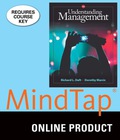
To determine:
If being in team for a prestigious and remarkable project will make you overlook the facts and be instrumental in making unethical decisions. Is highlighting the issues will have a positive impact on project and on the individual?
Introduction / Case study:
A training program organized in MicroPhone, a telecommunication company for customer service project. It is lead by Kristin Cole who is Head of HR. Sara MacIntosh joined into the organization reporting to Kristin into their training operations. The above training is a week program for 3000 employees with a cost of $40 Million. However after looking into the extensive details of the project Sara understood that it is going to cost more than that if the training has to be continued the way it is planned for.
She reported to Kristin about her concerns however Kristin was not ready to listen. Also she demanded Sara to organize it and make it successful with said budget and there will not be any changes. If Sara decides to raise a voice against this and take it to the attention of team involved in training activities what will be the impacts?
Trending nowThis is a popular solution!

Chapter 10 Solutions
MINDTAP MANAGEMENT FOR DAFT/MARCIC'S UN
- Are frequency distributions the only methods that researchers use to organize data? Yes or No Discussarrow_forwardAre frequency distributions the only methods that researchers use to organize data? Yes or No Discussarrow_forwardAre frequency distributions useful to organize data? Please discuss and provide examples where necessary.arrow_forward
- 6. The first step in starting the research process is.. a) Searching for solutions to the problem b) Identification of the problem c) Survey of the related literature d) Searching sources of information to locate problem 7. Which of the following is NOT a form of nonrandom sampling? a) Quota sampling b) Purposive sampling c) Snowball sampling d) Convenience sampling 8. The ability to generalize the results of a study is related to.... a) External validity b) Manipulation c) Internal validity d) Predictive validity 9. Which of the following is of least concern to a qualitative researcher? a) trustworthiness b) Validity. c) Generalizability d) Understanding 10. The most important consideration in selecting a sample is that it should be........ a) Selected from a large number of individuals or elements b) Selected from the population by means of a table of random numbers c) Made up of a large number of subjects d) Representative of the populationarrow_forwardQuestion 4 Outline some suggestions regarding how to word interview questions. (10 marks)arrow_forwardQuestion 3 But even with the best survey and the best results, action won't happen on its own. Your task as a business owner is to make sure the results are used. What can you do to make this happen? (8 marks)arrow_forward
- Outline the steps to follow when starting to create the business report. (6 marks)arrow_forward7. Which of the following is NOT a form of nonrandom sampling? a) Quota sampling b) Purposive sampling c) Snowball sampling d) Convenience sampling 8. The ability to generalize the results of a study is related to......... a) External validity b) Manipulation c) Internal validity d) Predictive validity 9. Which of the following is of least concern to a qualitative researcher? a) trustworthiness b) Validity c) Generalizability d) Understanding 10. The most important consideration in selecting a sample is that it should be.... a) Selected from a large number of individuals or elements b) Selected from the population by means of a table of random numbers c) Made up of a large number of subjects d) Representative of the populationarrow_forward6. The first step in starting the research process is.. a) Searching for solutions to the problem b) Identification of the problem c) Survey of the related literature d) Searching sources of information to locate problem 7. Which of the following is NOT a form of nonrandom sampling? a) Quota sampling b) Purposive sampling c) Snowball sampling d) Convenience sampling 8. The ability to generalize the results of a study is related to.... a) External validity b) Manipulation c) Internal validity d) Predictive validity 9. Which of the following is of least concern to a qualitative researcher? a) trustworthiness b) Validity. c) Generalizability d) Understanding 10. The most important consideration in selecting a sample is that it should be........ a) Selected from a large number of individuals or elements b) Selected from the population by means of a table of random numbers c) Made up of a large number of subjects d) Representative of the populationarrow_forward
- 1. In which section of the research plan are the research participants described in details? a) Introduction b) Data Analysis c) Discussion d) Methodology 2. The feasibility of a research study should be considered in light of....... a) All of the above b) Potential ethical concerns c) Skills required of the researcher d) Cost and time required to conduct the study 3. Which of the following best describes quantitative research? a) Research that is exploratory b) An attempt to confirm the researcher's hypothesis c) The collection of non-numeric data d) Research that attempts to generate a new theory 4. The Qualitative research is often exploratory and has all of the following characteristics Except a) It is typically used when a great deal is already known about the topic of interest b) It relies on the collection of non-numerical data such as words and pictures c) It is used to generate hypotheses and develop theory about phenomena in the world d) It uses the inductive scientific…arrow_forwardExplain the attributes of an effective corporate leader.arrow_forwardBriefly discuss how corporate governance may enhance corporate social responsibilities. Discuss how corporate governance can enhance corporate social responsibilities.arrow_forward
 Management, Loose-Leaf VersionManagementISBN:9781305969308Author:Richard L. DaftPublisher:South-Western College Pub
Management, Loose-Leaf VersionManagementISBN:9781305969308Author:Richard L. DaftPublisher:South-Western College Pub Understanding Management (MindTap Course List)ManagementISBN:9781305502215Author:Richard L. Daft, Dorothy MarcicPublisher:Cengage Learning
Understanding Management (MindTap Course List)ManagementISBN:9781305502215Author:Richard L. Daft, Dorothy MarcicPublisher:Cengage Learning

